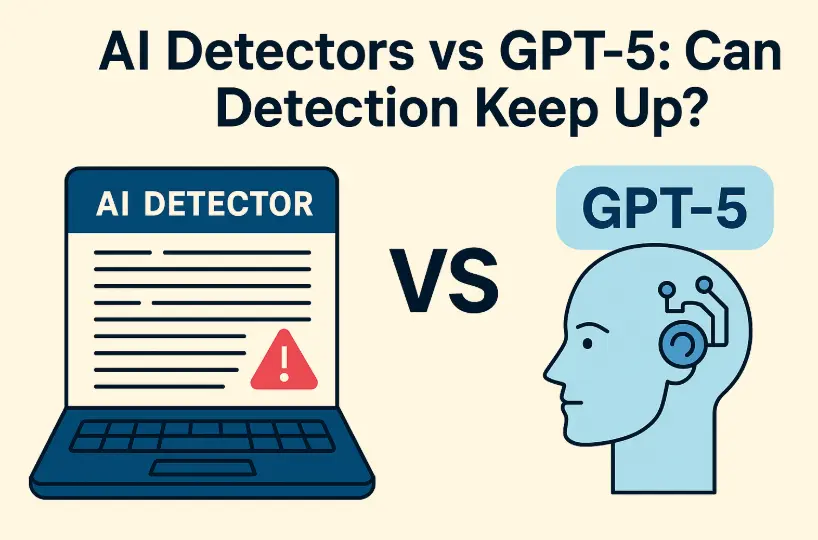The New Wave of AI Writing
The rise of GPT-5 marks a shift. It writes in ways that feel close to how people talk and think. Past models left clues. Sentences felt flat. Word flow looked off. GPT-5 hides those clues well. This makes it much harder for tools to find out if text is real or machine-made.
The need for strong tools is clear. Schools want fair tests. Firms want to keep trust. Search engines want clear rules for ranks. This is why the race between GPT-5 and detectors is now more fierce than ever.
What GPT-5 Brings to the Table
GPT-5 is not just a step up in size. It is built to be smart in style and tone. It can:
- Switch voices with ease.
- Add detail that fits the theme.
- Keep long form text in line without loss of flow.
- Hide the “AI feel” that past models gave away.
The leap is not just in raw power but in skill. Each word choice looks less like math and more like art. For users, this means better text. For detectors, it means a big new task.
Why AI Detectors Exist
An AI detector looks for marks of machine text. It checks how words link, how often they show, and if the rhythm feels forced. Tools help:
- Schools spot work that may not be the student’s own.
- Firms make sure blogs and posts meet trust rules.
- News sites keep fake or bot-made text off their pages.
Detectors give a way to judge text in a world where AI writes fast and at scale. Without them, trust in words would fade.
How AI Content Checkers Work
An AI content checker is not just one test. It runs a set of scans, such as:
- Word use: Machines tend to pick safe, mid-range words.
- Flow: Human text has mix, breaks, and odd turns.
- Tokens: AI tools rely on token math, which can show patterns.
- Burstiness: People use short, long, and mid words in mix. AI may not.
Some tools even look at single lines. Others check a block of text as one piece. The blend gives a score that says if text may be AI.
Why Old Detectors Fail on GPT-5
GPT-5 breaks the old frame. It:
- Mixes burst and tone well.
- Uses rare words with skill.
- Keeps style fresh through long text.
- Fakes the human “mess” that machines once lacked.
This makes false reads grow. A tool may say a human text is AI. Or it may miss AI text that is well made. Both cases hurt trust.
The Arms Race
The story is not one side. It is a race:
- GPT-5 grows smart, smooth, and more human-like.
- AI detectors grow sharp, new, and more strict.
- Each new step from one side sparks a new move from the other.
The loop will not stop. As AI grows, so must the tools that guard against misuse.
Case Study: Schools
A school gets a set of essays. Some feel too neat. The teacher runs them through a tool. The AI detector flags parts as high risk. The teacher checks by hand and sees the same style hint. With this blend, the school can act fair. But if the tool gives false reads, a real student may face harm. This risk shows why tools must be both strong and fair.
Case Study: SEO and Firms
A small firm runs a blog to bring in new leads. The team wants each post to rank well on Google. Before they publish, they use a tool for Detecting AI text. This helps them check if a post looks like it was made by AI. If the post fails the check, they can edit it. This way, the firm lowers the risk of search rank loss and keeps trust with readers.
Tools in 2025
The new wave of tools add fresh steps:
- Multi-detectors: Use more than one scan to cross-check.
- Sentence checks: Flag line by line, not just a whole page.
- Trend watch: Learn from new AI models as they grow.
- Human review add-ons: Let a person check key parts.
These tools aim to fix the gap GPT-5 made. They bring more fine scans to cut down false reads.
The Human Factor
No tool is full proof. A smart review is still key. People can see context. They know tone, style, and the point of the text. The best results come when tools and people work side by side. An AI detector can flag risk. An AI Humanizer can then reshape the text into a style that feels closer to real human work. With both steps, it is easier to judge fairly and avoid mistakes.
The Risks of False Reads
- False Positive: A real student is marked as fake. Trust breaks.
- False Negative: A full AI text passes as real. The system fails.
Both cases hurt. For this, tools must keep a low error rate. As GPT-5 makes AI text close to human, this is hard. But it is key.
The Next 3 Years
We can expect:
- Smarter scans that track token depth.
- New laws in schools and firms that need proof of text source.
- Bigger use of AI detectors in news, SEO, and jobs.
- Push for open reports that show how tools work.
- AI vs AI battles where one AI writes and the other AI checks.
Can Detection Keep Up?
The short word is yes, but with effort. Tools will not stop all AI text. But they can mark risk, lower fraud, and guide fair use. As GPT-5 grows, so too will the need for sharp, fast, and fair checks.
The race is not one that ends. It is one that keeps going. AI will grow. Detectors will grow. The key is to keep balance so trust in words stays strong.
